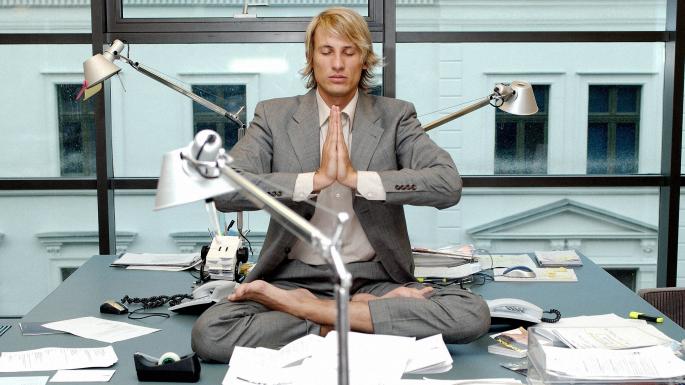Mindfulness has numerous benefits, from lowering stress levels to helping with anxiety and depression to helping you regulate your emotions.
And mindfulness can especially help at work, offering improved focus, better memory, the ability to stay calm under fire and better corporate citizenship, according to one Harvard analysis.
But most employers aren’t building Meditation Corners into their offices and encouraging workers to take 20 minutes to quiet their minds. (Although some of them are.)
So, with all the benefits of mindfulness, how do you squeeze it into an already packed work schedule? Here’s what these people do:
Find some early quiet.
“I come into work early and I take the first fifteen minutes of my day to quietly prepare for the day to come, including personal to-do lists and work to-do lists allowing me a bit of mindfulness time of my own.” –Charly Rok, public relations VP, New York, NY
“I fit mindfulness into my day right when I wake up in the morning. I take a couple of minutes to reflect on everything I am grateful for and not just what’s obvious, like family and health, either. I express gratitude for mundane, everyday things that might ordinarily be taken for granted, like a safe neighborhood to live and work in or a card I received in the mail from a friend. Doing this bit of inner reflection every morning helps me set the tone for my day and gradually adjust my mindset to keep from sweating the small stuff.” –Deborah Sweeney, CEO, MyCorporation.com, Calabasas, CA
“I have been practicing Tai Chi for nearly 20 years. First thing in the morning has always been the time I set aside for my practice. I get up, start making coffee, and practice my Tai Chi. I combine Tai Chi and Qi Qong (meditative breathing practices) into a 15-minute session. Developing mindfulness is like sports or musical training. The benefit is derived through repetition and consistency.” –Alan Zucker, project management instructor and consultant in Arlington, VA
“When I wake up in the morning, I take 15 minutes to write down three things I’m grateful for and three of my intentions for the day. It really helps me to focus and nurtures an abundance mindset.” –Colleen Welsch, a freelance writer and digital marketing expert in Youngstown, OH
Eat with intention.
“Whenever possible, I take at least one meal or snack break a day mindfully, and when able, in silence. I pay attention to all the senses: sights, sounds, smell, texture of the food and, of course, taste. I have even guided clients through five minutes of paying attention to eating a single raisin. When you slow down, it’s amazing what you notice about food and your relationship to it, and it usually leads to better choices and healthier portions.” –Urszula Klich, Ph.D., a licensed clinical psychologist in Los Angeles and Atlanta
Take a break.
“When I’m at work, I use mental breaks, which can be anything that allows me to step away from what I’m doing and clear my mind. Some of my favorite mental breaks are to walk to a nearby coffee shop and grab a cup of coffee or put on my headphones and go listen to a few of my favorite songs away from my desk. That works for me because I love coffee and music. I don’t schedule these breaks for set times. Instead, I just work them in based on my energy levels and when I feel that I’m starting to drag or beat my head against a problem too much.” –Orlando O’Neill, director of marketing consultancy firm Fjuri in Seattle, WA
Use a prompt.
“When working, I have a little ritual I do after I check something off my list. I pause and take a few deep breaths before moving on to the next task. Checking something off my list becomes a cue to take a mini mindfulness break.” –Kim McIntyre, yoga teacher, meditation teacher and stress relief specialist in Orlando, FL
Use your commute.
“I take the train to work every day. The train ride is 35 minutes each way, and I use the last 20 minutes to practice mindfulness, both to and from work.” –Jim Zamichieli, marketing professional, Philadelphia, PA
“I have 10 minutes every morning between my son’s daycare and my office. That is my time to breathe. Literally, I take a deep breath and try to be present on my trip to the office. My first thought is gratitude for something in my life—mostly the moments from the night before or the silly things my kids say or do. Then I will think of one personal and one professional goal I can achieve today—big or small. It may seem silly, but it keeps me balanced, no matter how crazy the morning started.” –Kristin Kane Ford, social media director in Lansdale, PA
Slow down your chores.
“When I’m cleaning up or washing dishes, I use the motion of wiping the dishes to slow my breathing. Mindfulness doesn’t have to be complicated.” –Gina Lepore, executive coach in the New York City area
Find a creative outlet.
“A few years ago, as I was submitting my late mother’s poetry picture book to publishers, I started to try my hand at writing short poetry: haiku and senryu. As part of this creative exercise, I began to observe my surroundings more closely. I would sometimes slow down and linger over things I tended to overlook in the rush and distractions of daily life. I view haiku as a kind of poetic mindfulness.” –Amy Losak, Teaneck, NJ
End your day with reflection.
“At the end of the day, writing down three funny things that happen in your life each day is proven to increase overall feelings of happiness and decrease depressive symptoms for up to six months even if you only do it for a week. It begins to train your brain to see the humor of life in real time rather than just retrospect. Once you start doing this, you’ll notice that when something bad happens in life, instead of getting immediately upset, you’ll think ‘I’ll be writing this one down later tonight,’ which is when you know you’re beginning to train your mind to stay present and even see the humor in things.” –Paul Osincup, speaker and positive workplace strategist
From: Forbes



